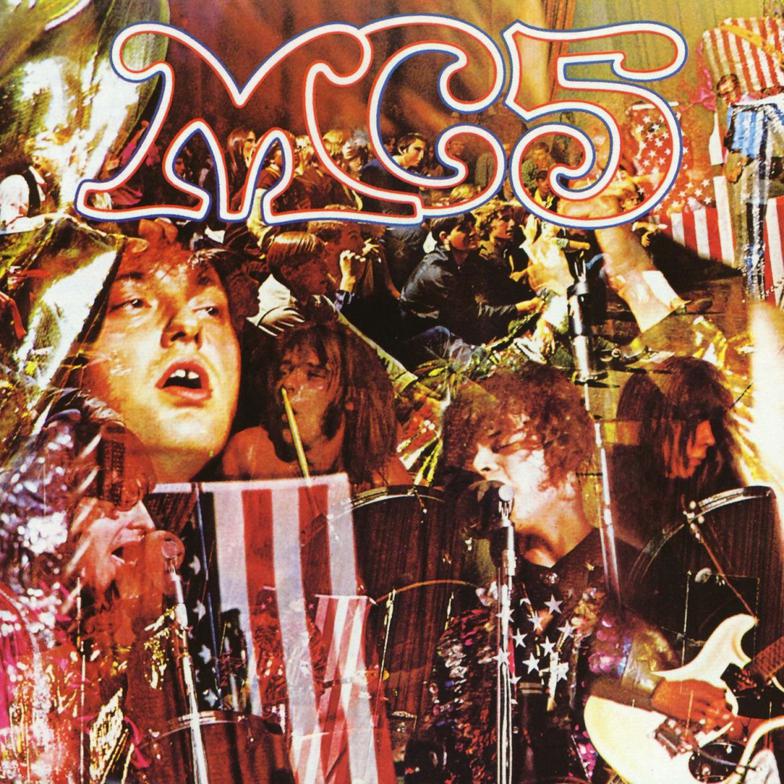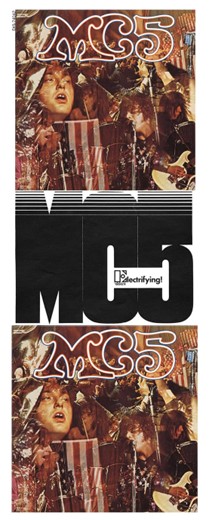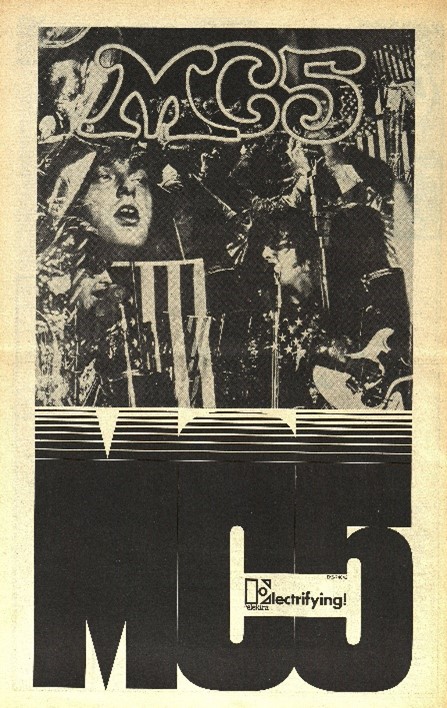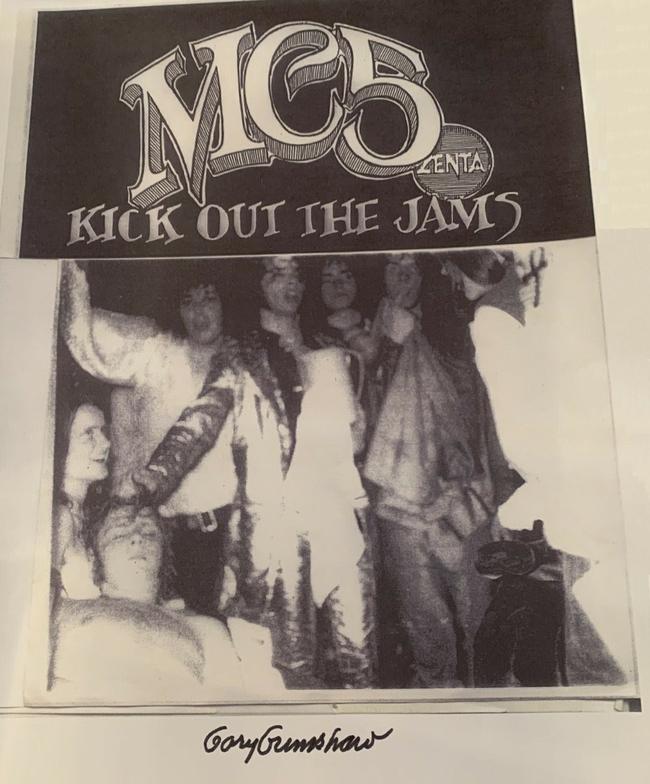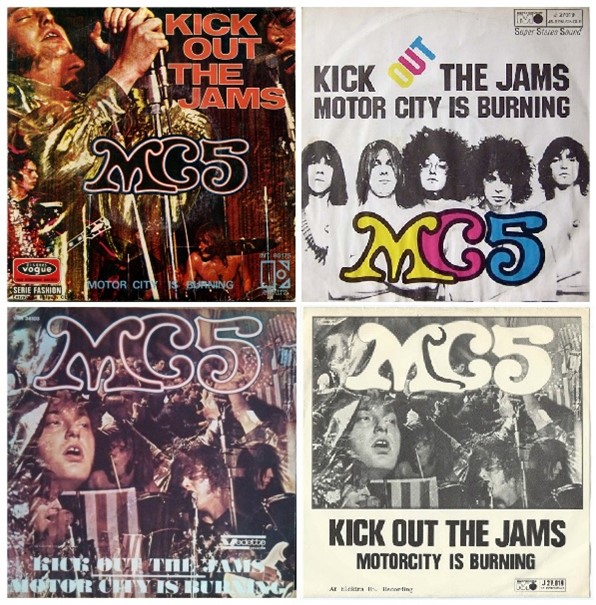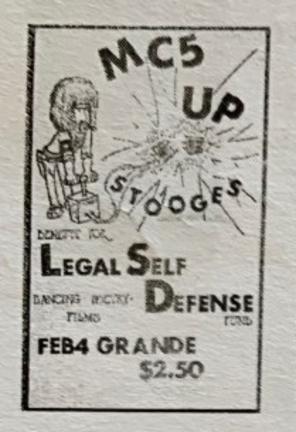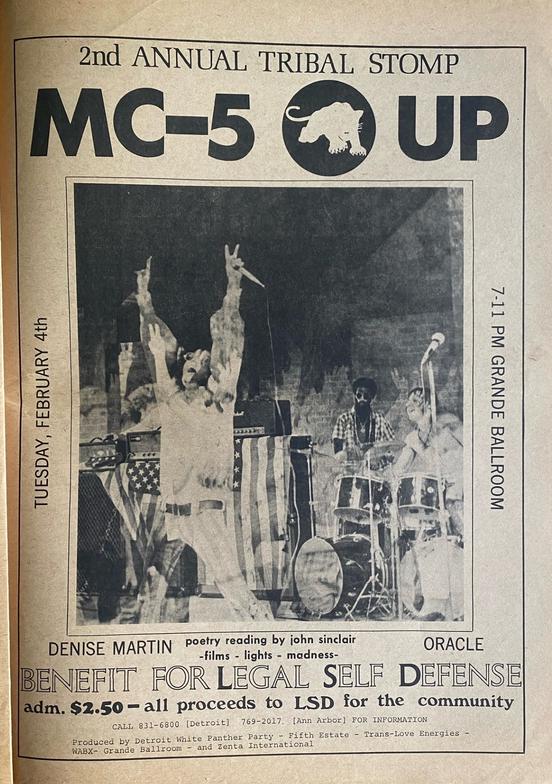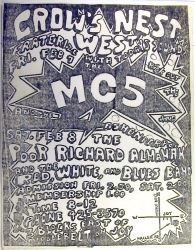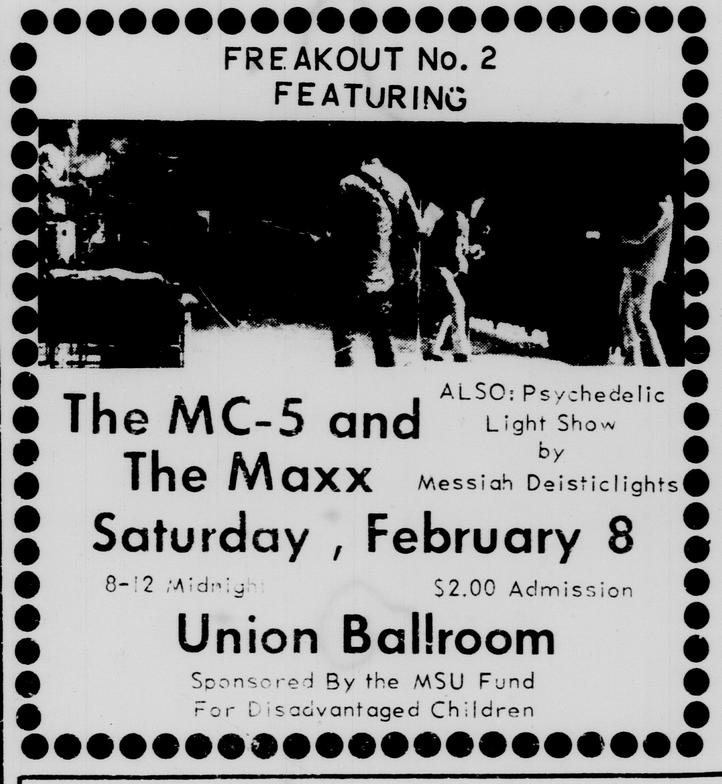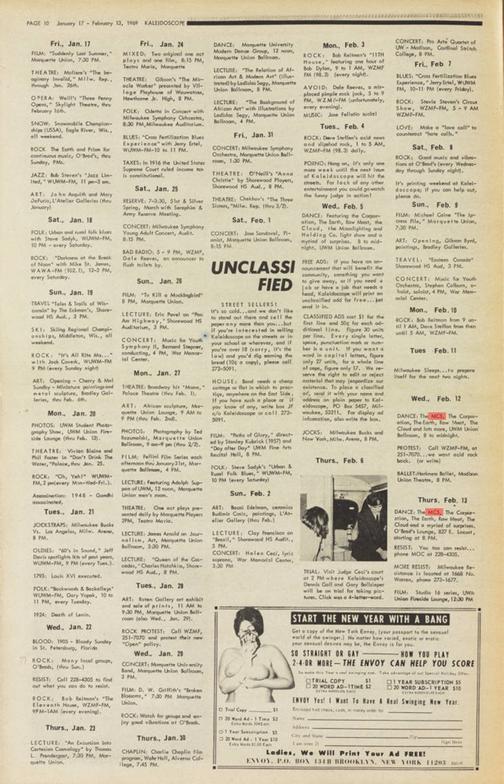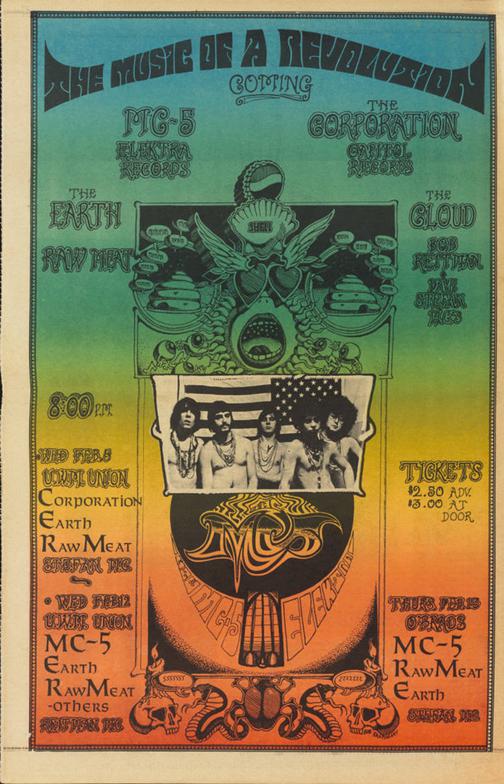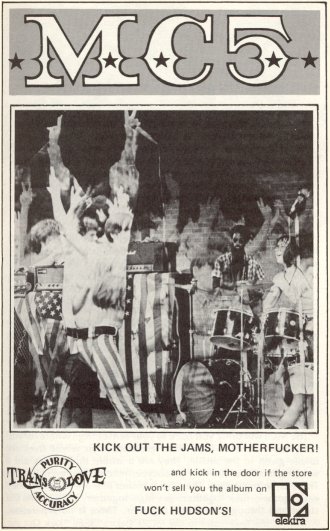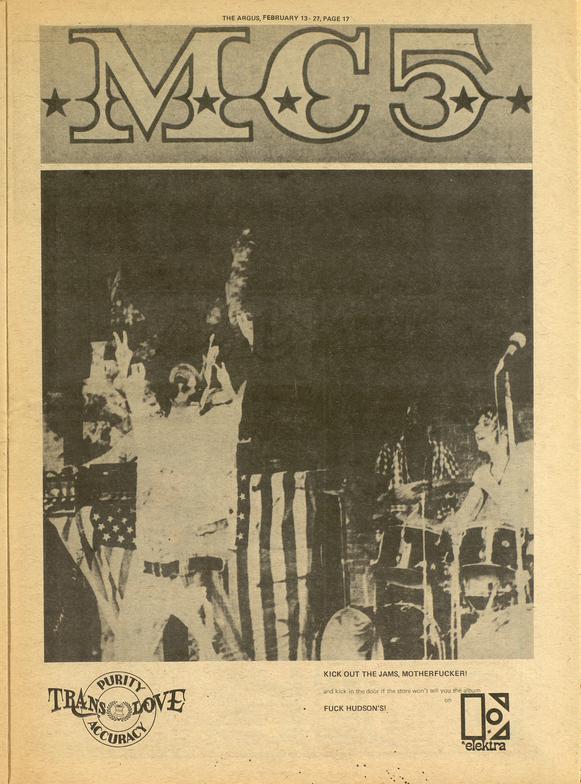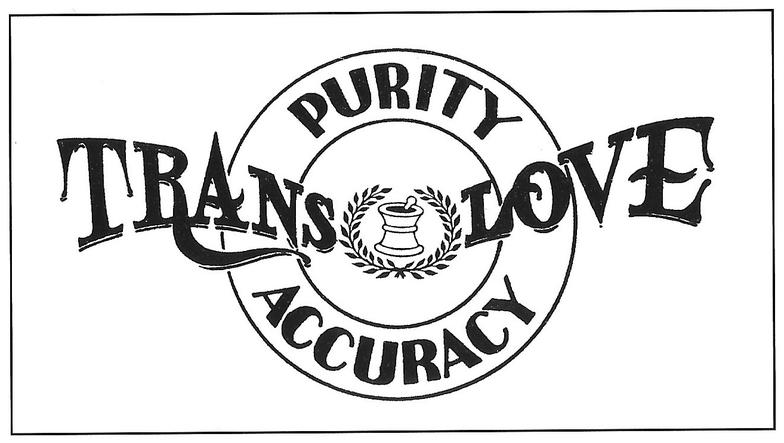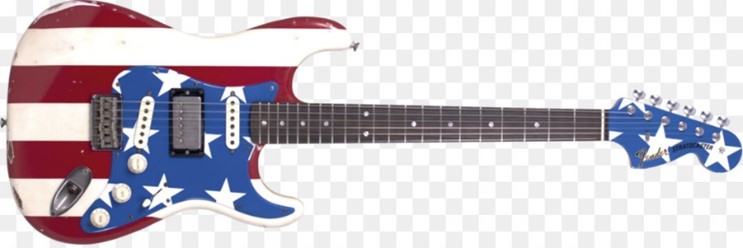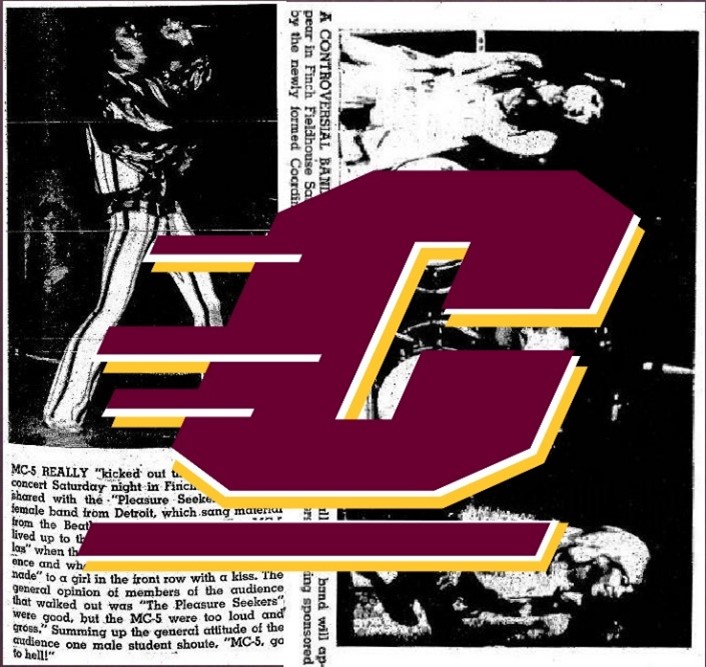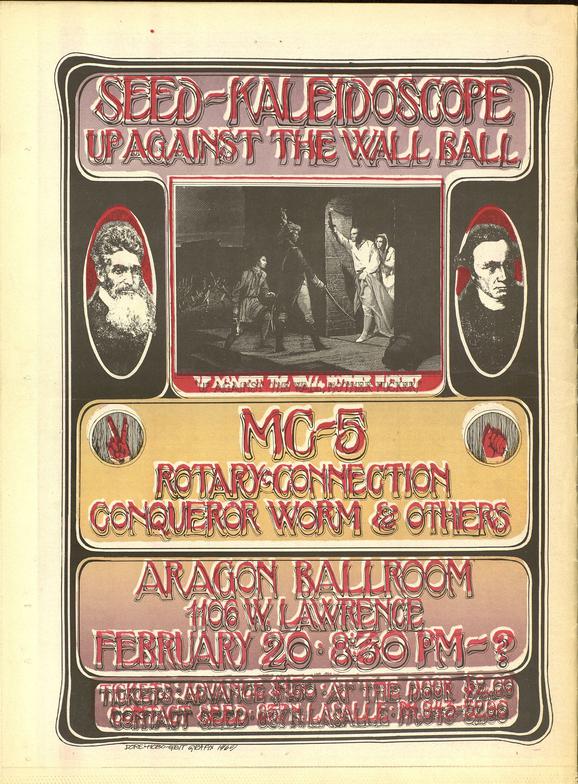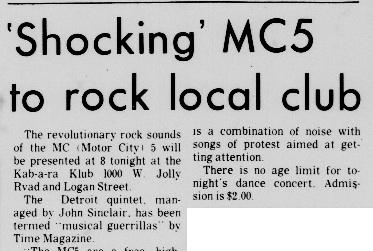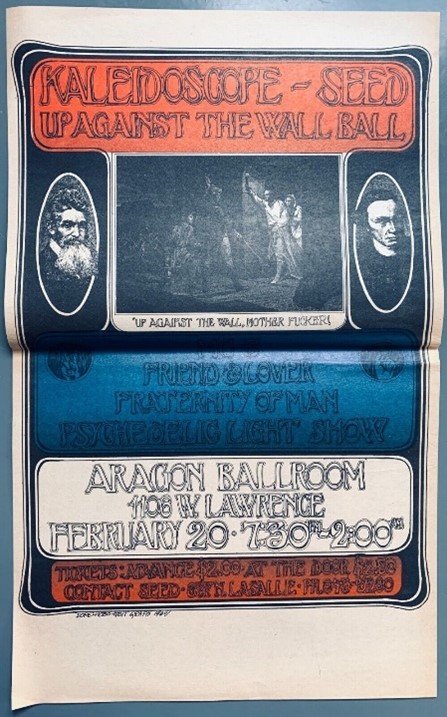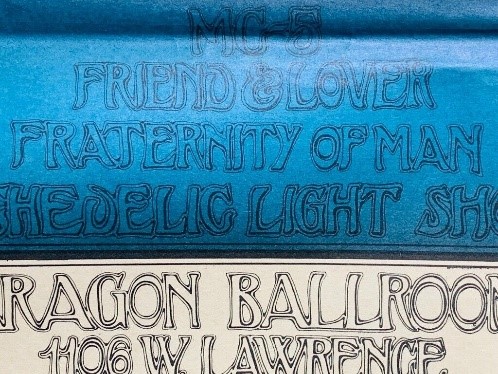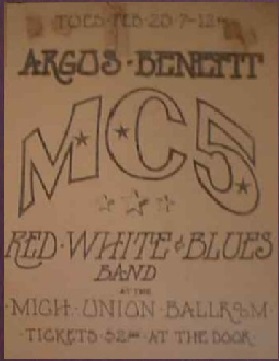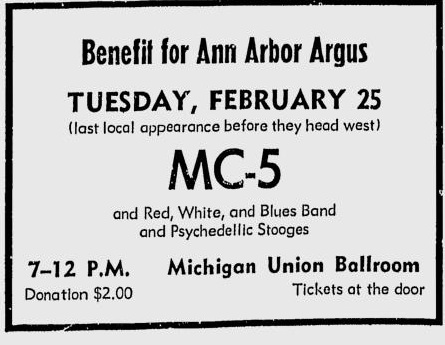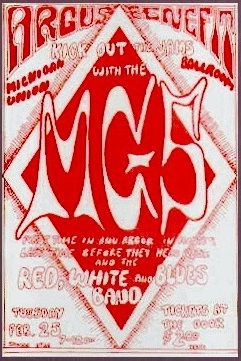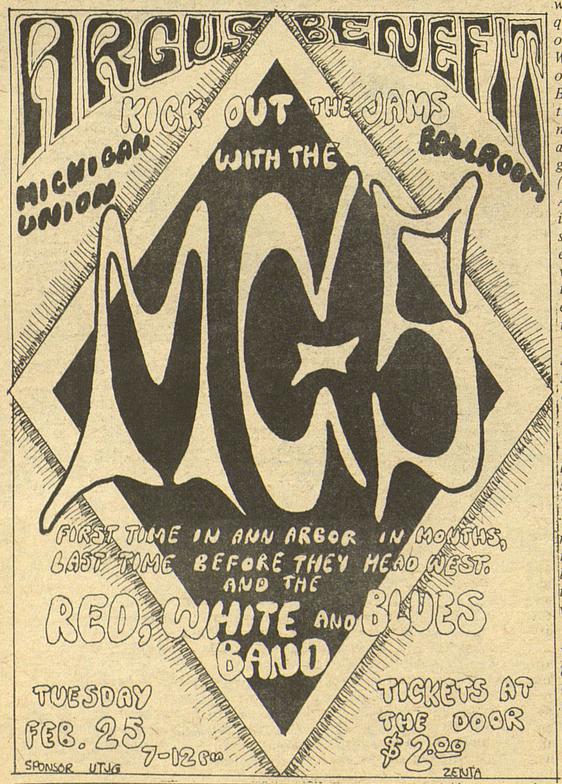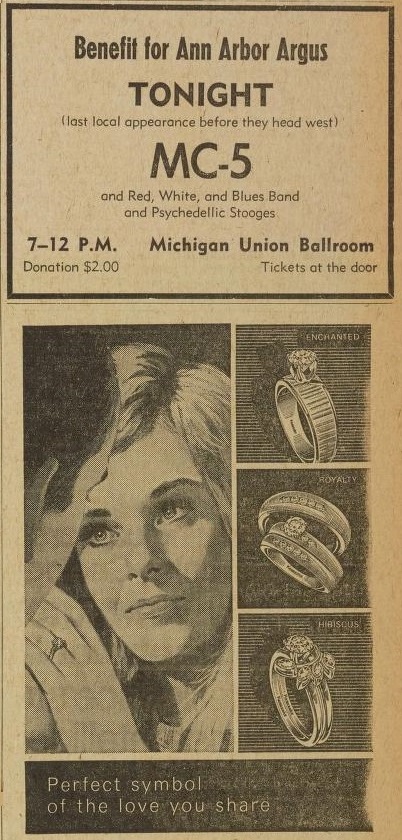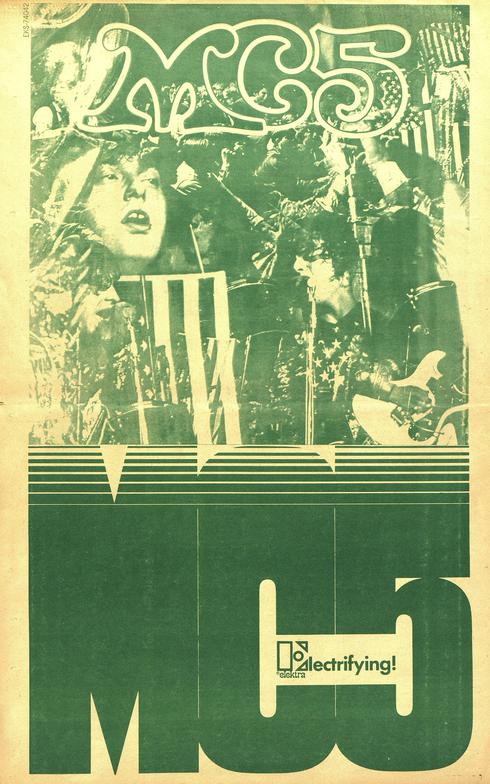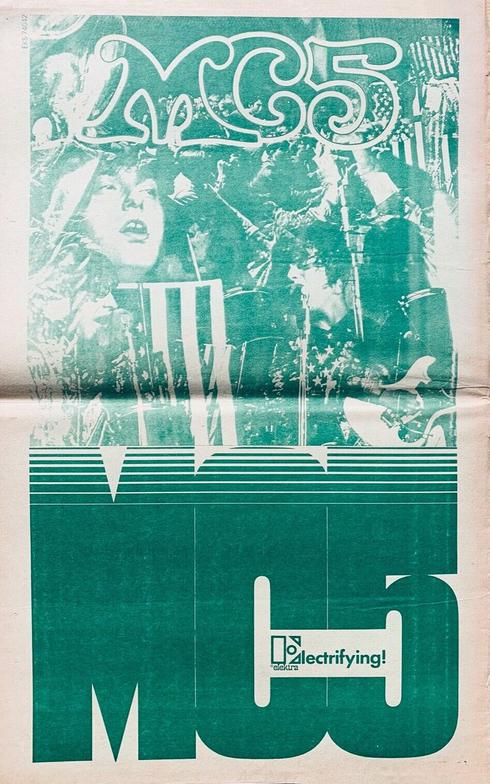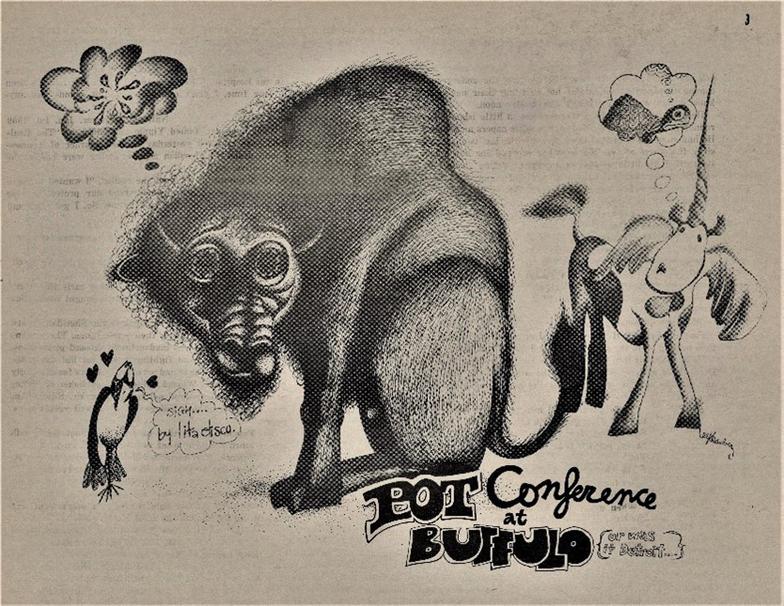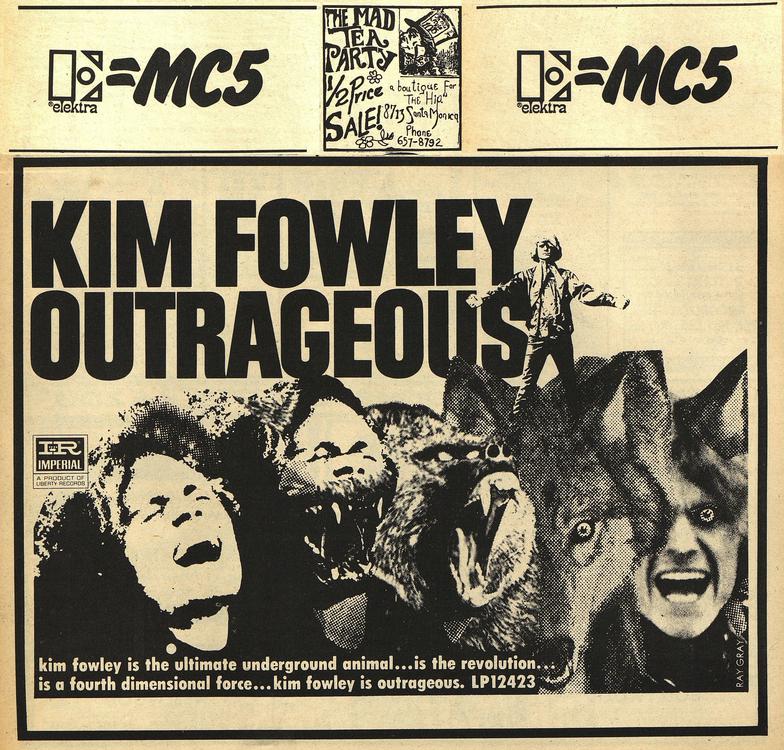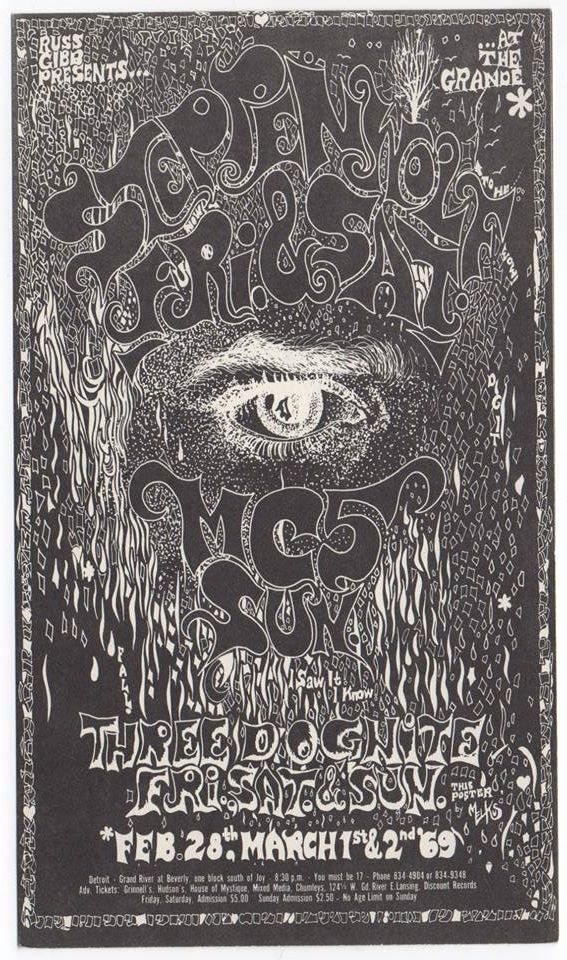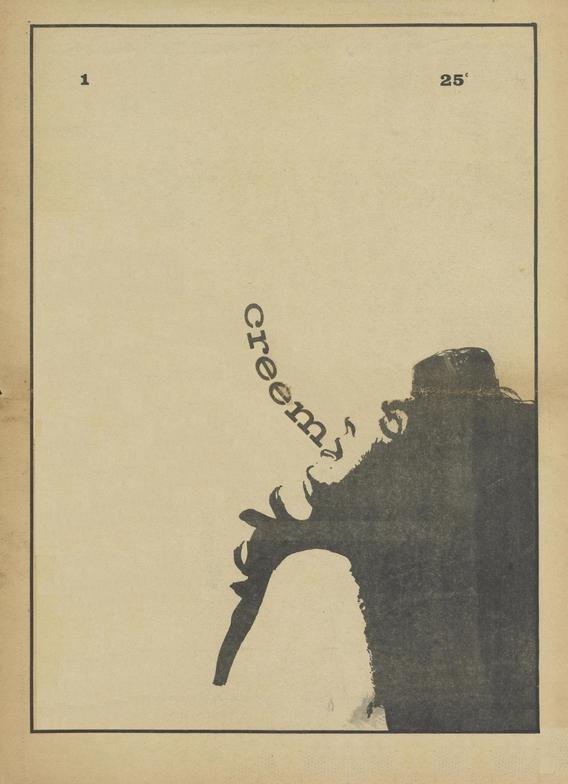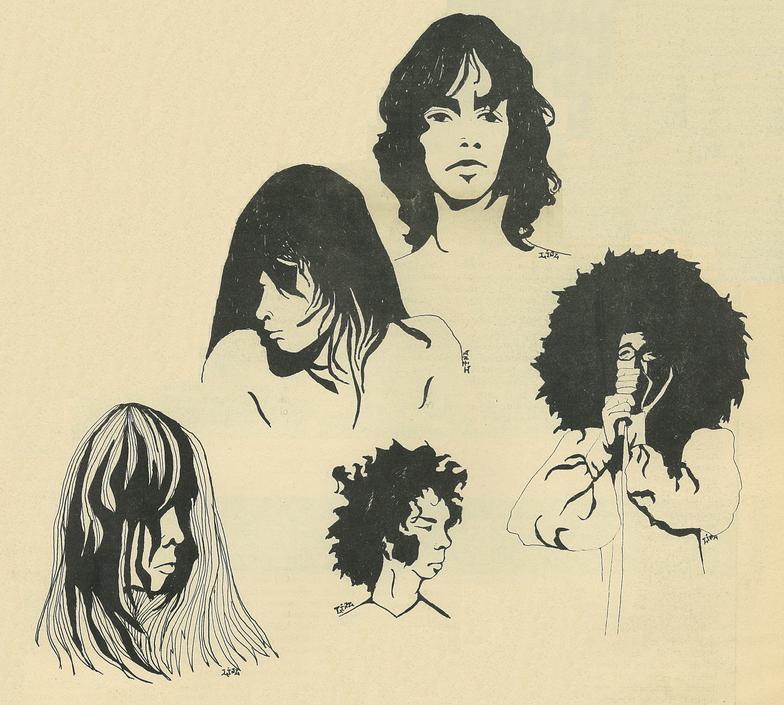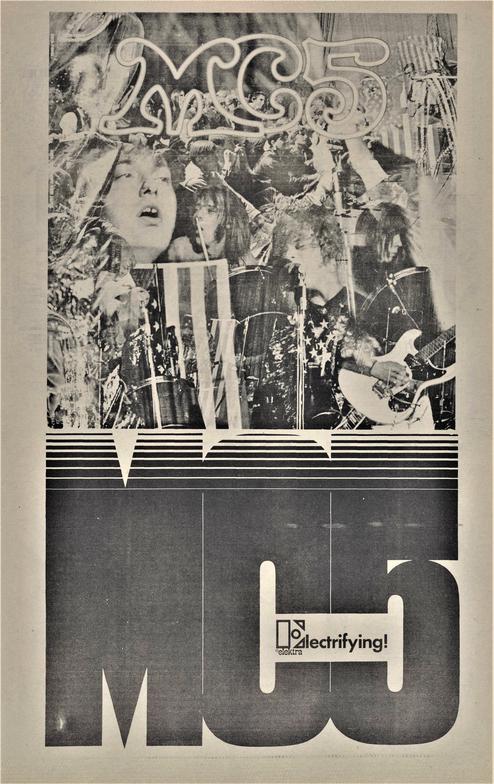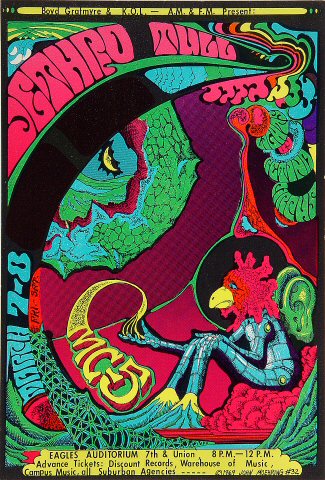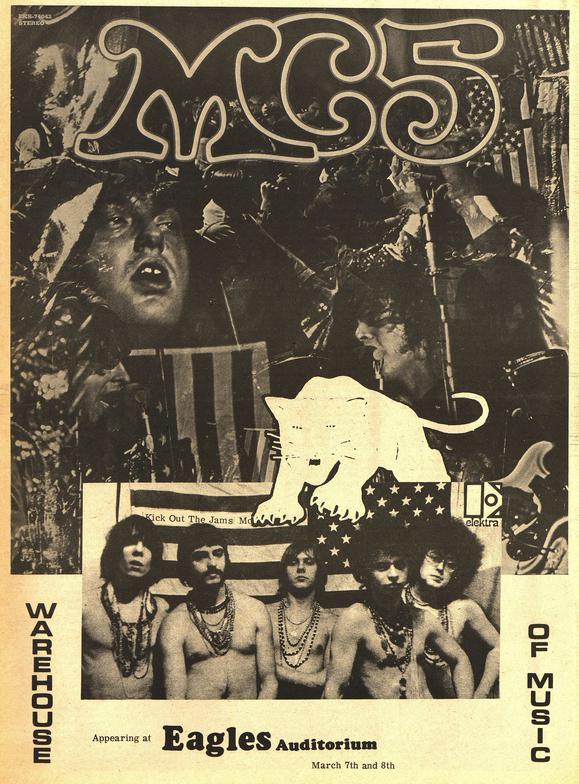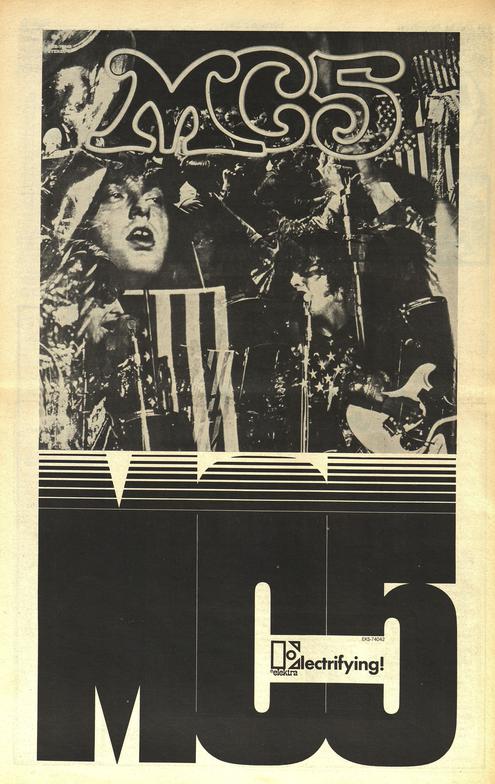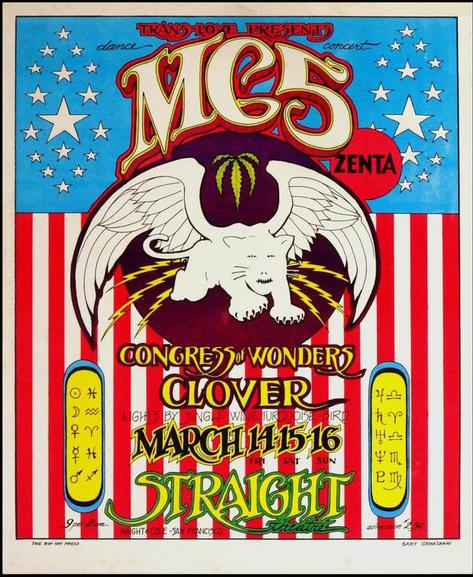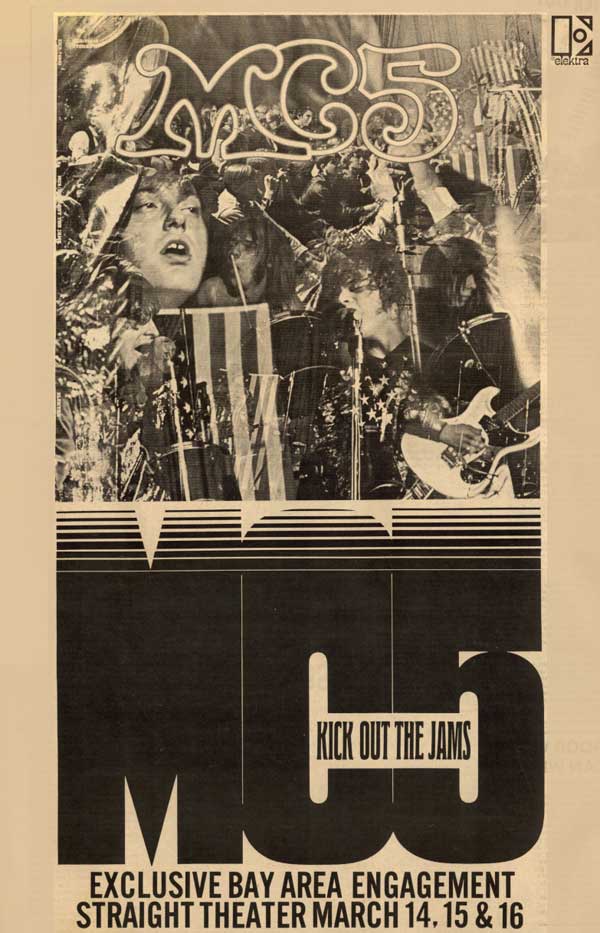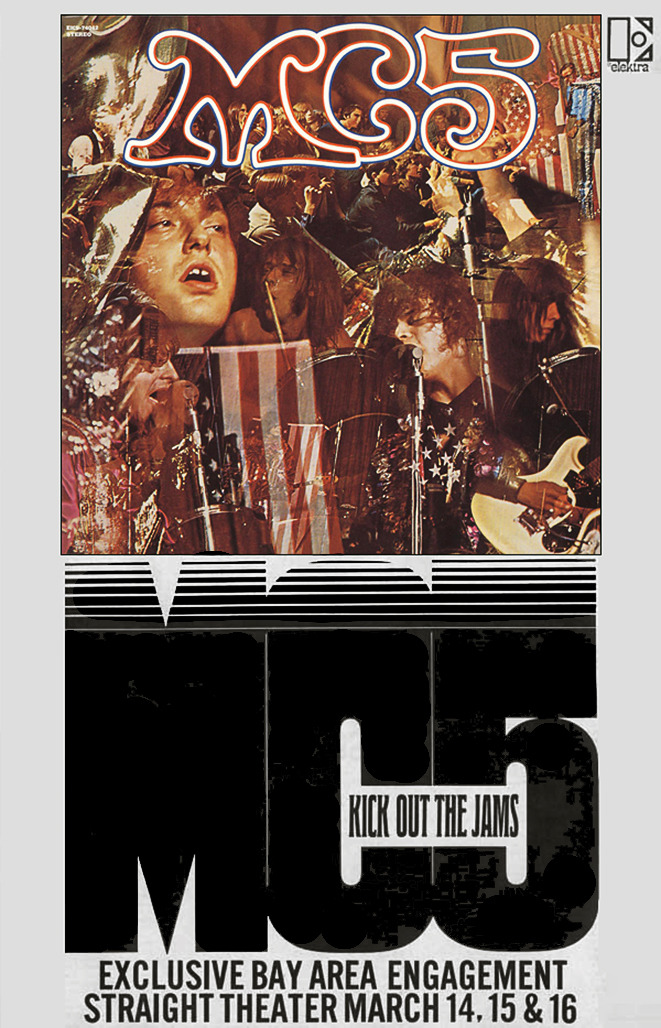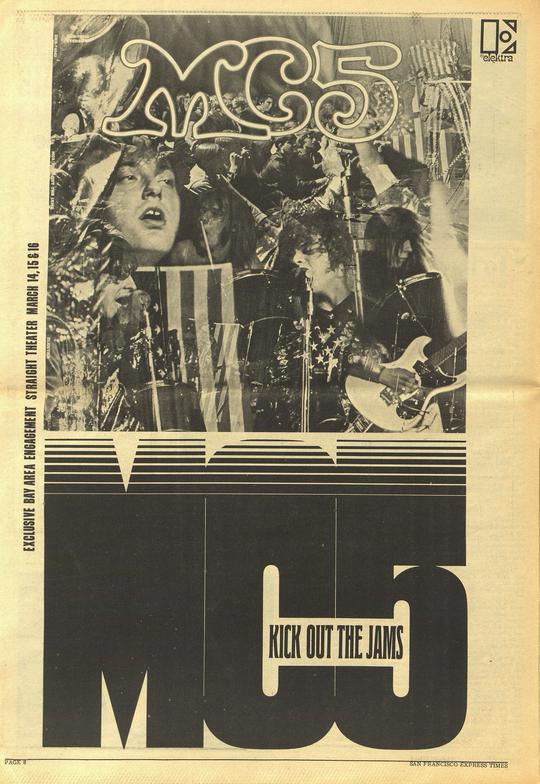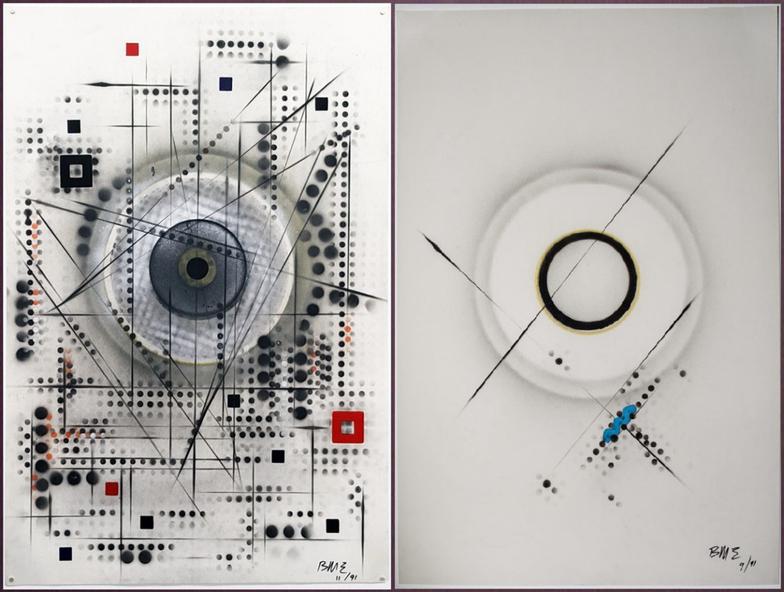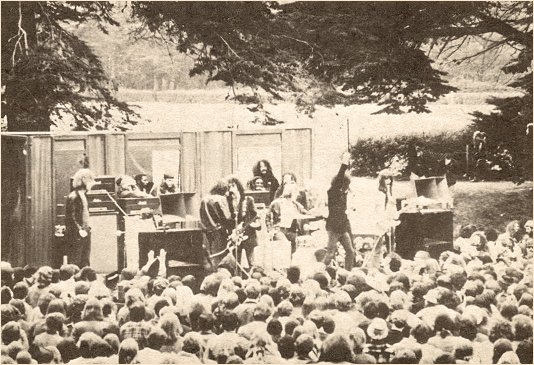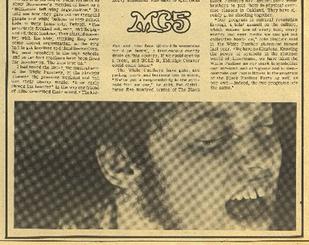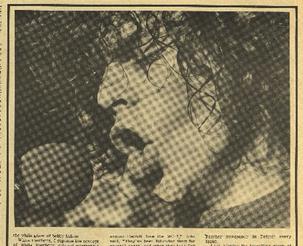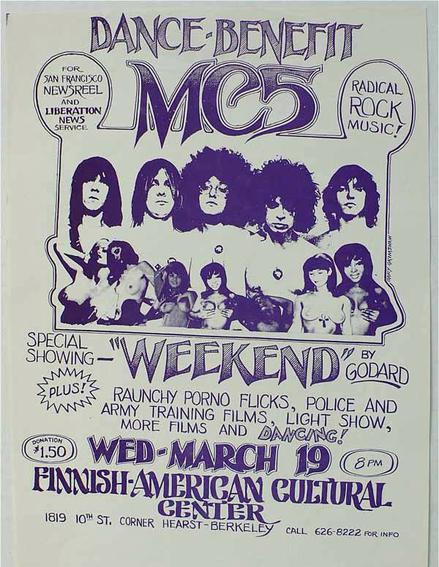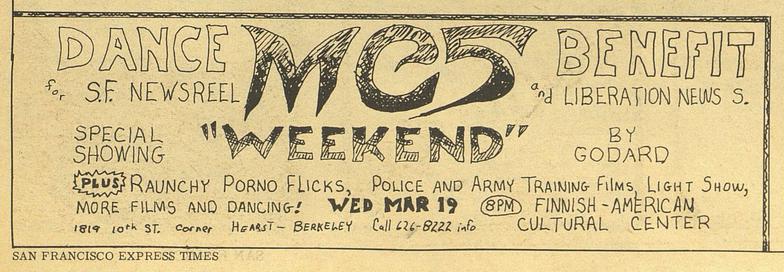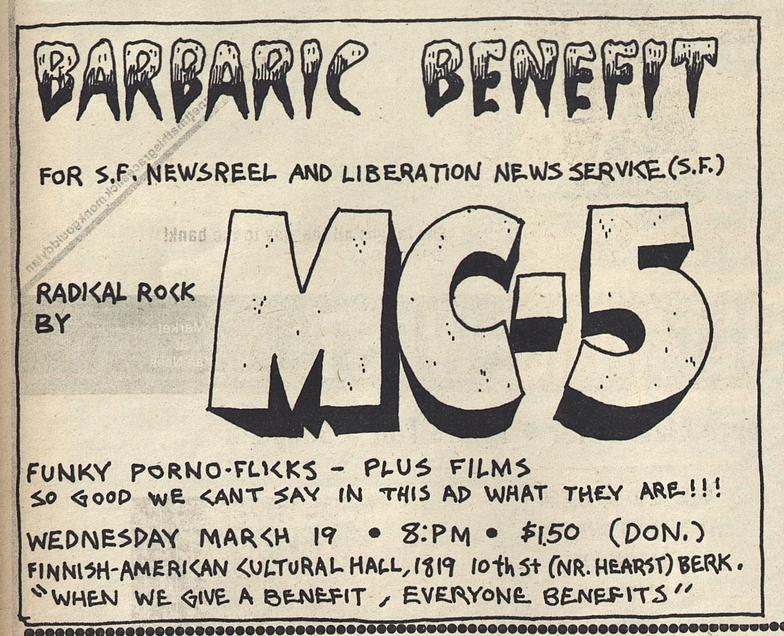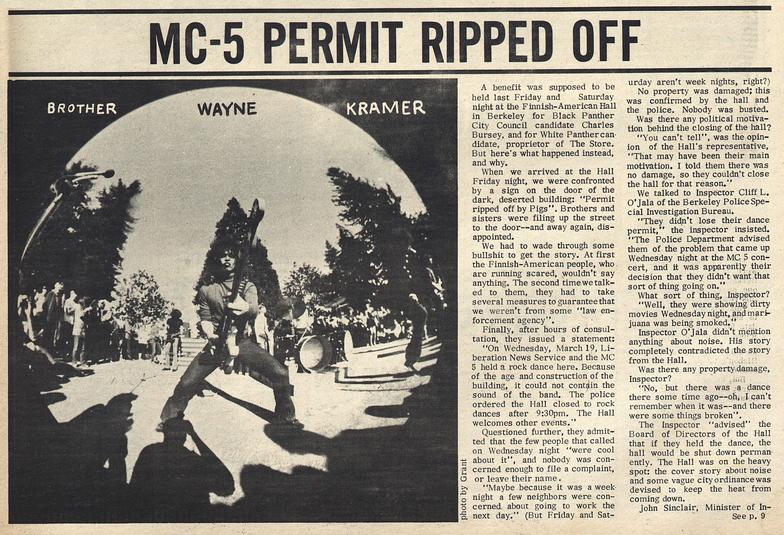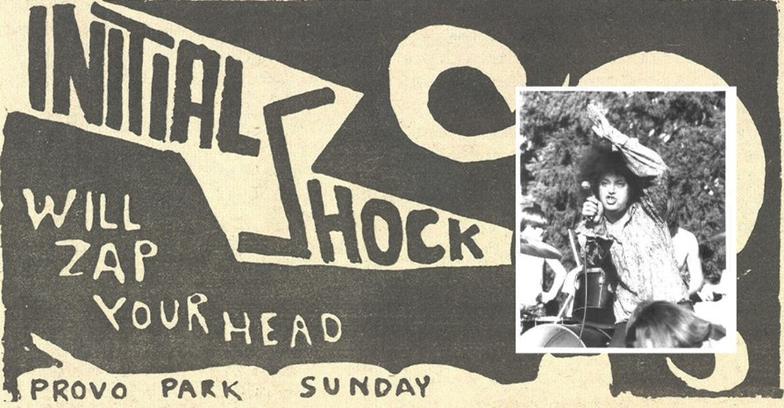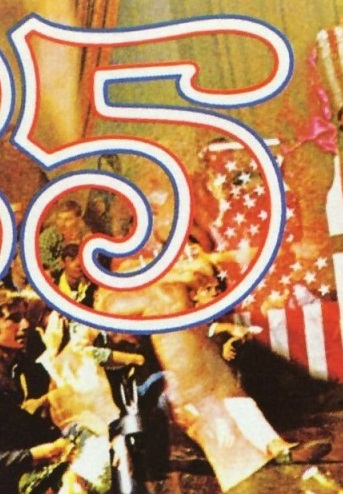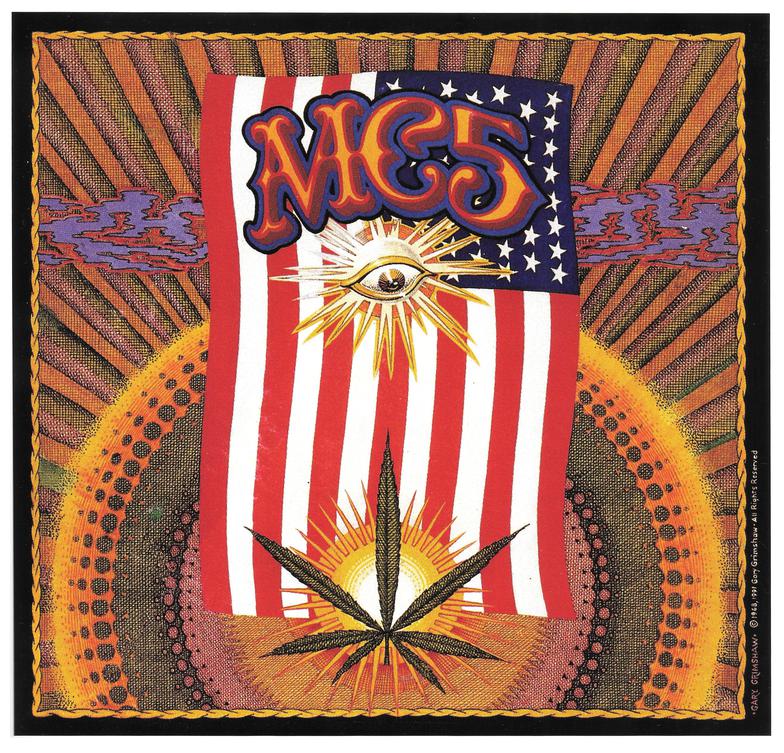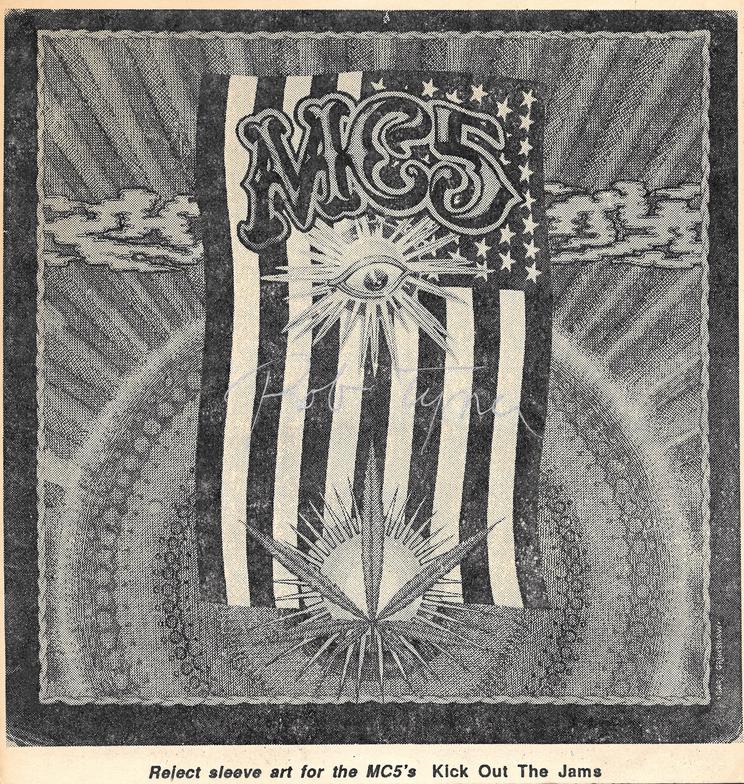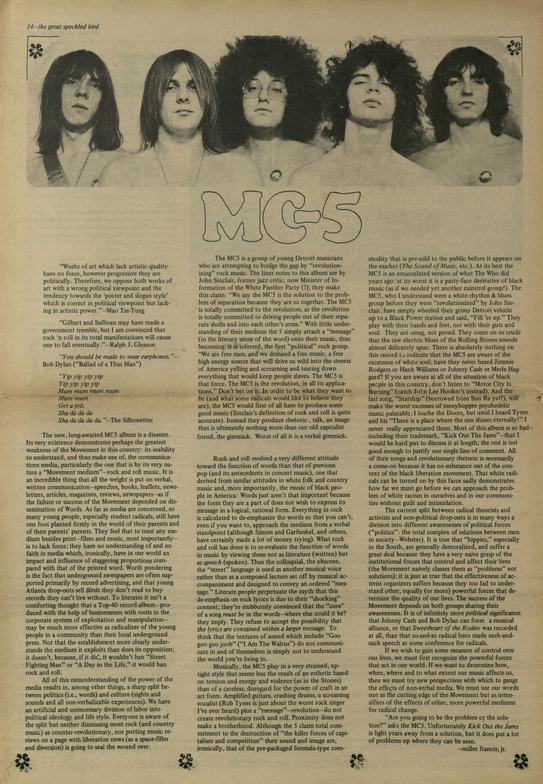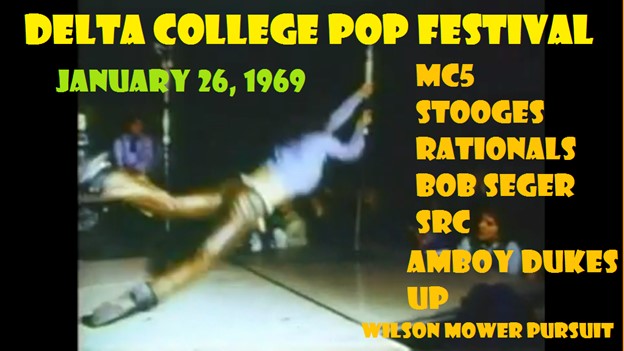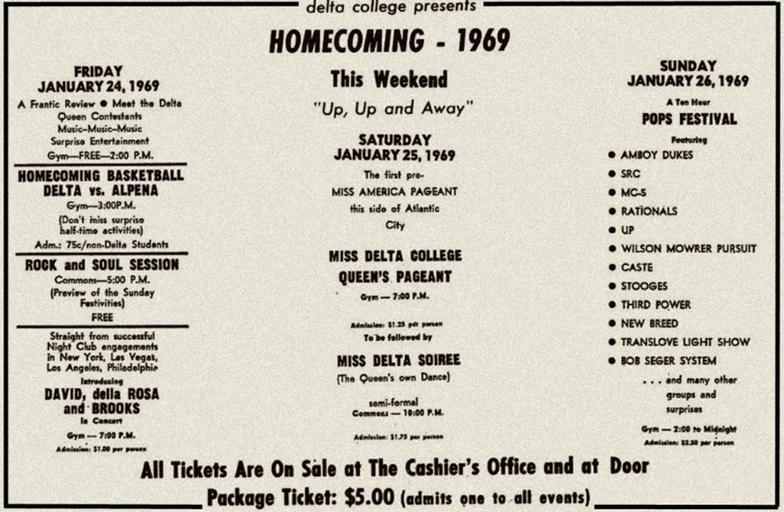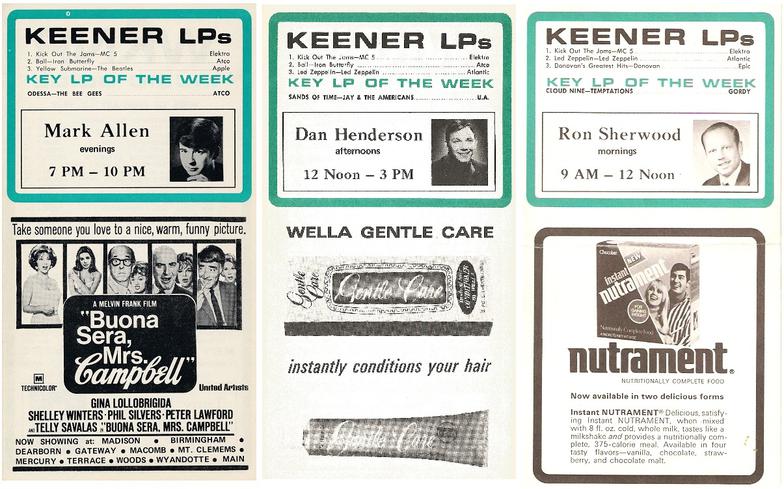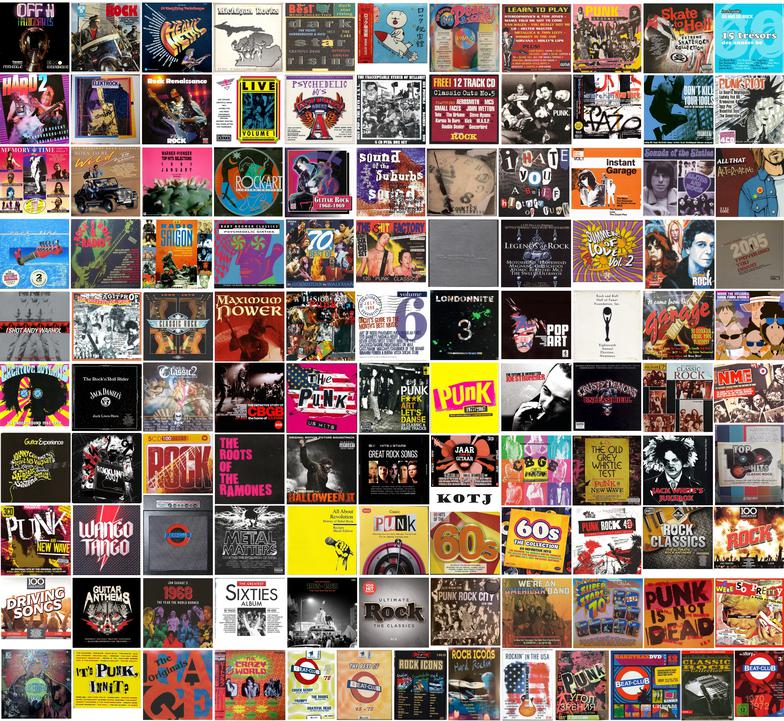Splatt Gallery
Double click here to add text.
Splatt Gallery's History of Michigan Music Posters
MC5 - Page Six
************************************************************
A nice high-resolution image of the front cover of the debut album by the MC5, released in February 1969. A good story about photographer Joel Brodsky, who created the cover using one camera, is found at Retro Kimmer’s top-notch “Detroit Rock N Roll Magazine” blog linked below (which is also the source of the above image):
https://www.detroitrocknrollmagazine.com/2014/01/kick-out-jams-lp-cover-artist-joel.html
An Elektra Records promo poster for the debut album by the MC5, released in February 1969.
A full-page Elektra Records ad for the first album by the MC5, circa February-March 1969.
Poster/flyer by Gary Grimshaw, likely to promote the release of the “Kick Out The Jams” album by the MC5 in February 1969.
Picture sleeves from around the world, specifically France, Germany, Italy, and Sweden, for the title track single from the debut album by the MC5, “Kick Out The Jams”, released in February 1969.
Poster by an unknown artist, with a Frank Zappa-looking character exploding dynamite, for a benefit concert at the Grande Ballrooom on the night of February 4, 1969 to launch a new organization formed by WABX-FM radio, The Fifth Estate newspaper, Trans-Love, Zenta, and the White Panthers, called Legal Self Defense to create a community bail bond service, which reportedly raised $1,370. The MC5, UP, and the Stooges performed.
A full-page ad for the “2nd Annual Tribal Stomp” and “Benefit for Legal Self Defense” show at the Grande Ballroom in Detroit, Michigan on February 4, 1969.
Unknown poster artist for the Crow’s Nest West, February 7-8, 1969, with the MC5 on the first night, February 7, 1969.
Ad for the MC5 with The Maxx at Freakout No. 2 at the Union Ballroom in East Lansing, Michigan, February 8, 1969. The review in the State News called them “totally depraved”.
We have stumbled upon two shows by The MC5 that do not appear in any of the databases (nor do they conflict with anything in the databases), they appear to be two “lost” shows.
This is from the January 17 – February 13, 1969 issue of Kaleidoscope, an underground newspaper from Milwaukee, Wisconsin. The Unclassified section lists these upcoming events:
February 12, 1969 – UWM Union Ballroom – The MC5, The Corporation, The Earth, Raw Meat, The Cloud, and lots more
February 13, 1969 – O’Brad’s Lounge, 827 E. Locust – The MC5, The Corporation, The Earth, Raw Meat, The Cloud, and a myriad of surprises
We have confirmed that O’Brad’s Lounge in Milwaukee was indeed an active rock club at the time and was the residency of the Milwaukee band, The Shag.
Milwaukee is about a six-hour drive from Detroit, so it’s a conceivable road trip.
Glorious proof, by an unknown artist, of the two “lost” MC5 shows, February 12-13, 1969, in Milwaukee, Wisconsin.
When Elektra recorded the two nights at the Grande Ballroom, they also recorded the band performing their full set without an audience in the empty ballroom the afternoon between the shows. On this recording, Rob Tyner used the phrase “Brothers and Sisters” instead of “Motherfuckers” in the intro to “Kick Out the Jams”. The band knew that the “MF” version would never get played on the radio and assumed the afternoon recording would be the one used on the album, but Elektra proposed that the single use the clean version and that the album would have the MF version.
The original plan was to let the single run its course and release the album after a period of time, but the single started selling so well, reaching #2 on the CKLW and WKNR charts by the end of January, that Elektra couldn’t wait, the album was released and the complaints from parents was immediate. Record distributors and disc jockeys labeled the record “obscene” and retailers, in particular, Hudson’s, the largest department store in Detroit, refused to stock it.
In the second issue of The Ann Arbor Argus, an ad designed by Robin Sommers exclaimed “Fuck Hudson’s” and included the Elektra logo. Elektra wasn’t too happy about the use of their logo, or with the bill that Trans-Love sent them for the ad, but when Hudson’s retaliated by pulling all Elektra product off their shelves, the company went ballistic.
The MC5 – Kick Out the James (“clean” single version) (1968)
https://www.youtube.com/watch?v=N3TMuRGd3-0
The original ad in the February 13, 1969 issue of the Ann Arbor Argus newspaper.
“Purity Accuracy” logo for Trans-Love Energies.
In addition to his posters for the Grande Ballroom and other concerts, artist Robin Sommers also designed the controversial “Fuck Hudson’s” ad and painted Wayne Kramer’s American flag guitar.
Following is a three-part interview that Rich Dorris videotaped in 1993 in which Sommers tells the stories behind numerous Grand Ballroom posters and handbills, the album cover of the MC5’s “Kick Out The Jams”, and the Trans-Love Lightshows. Essential viewing.
Robin Sommers – Part One
https://www.youtube.com/watch?v=1GDMMPmowkE
Robin Sommers – Part Two
https://www.youtube.com/watch?v=brITFI32E18
Robin Sommers – Part Three
https://www.youtube.com/watch?v=vXCIak3L6jw
The MC5 were often paired on a bill with the Pleasure Seekers, as they were for a February 15, 1969 show at the Finch Fieldhouse on the campus of Central Michigan University in Mt. Pleasant. There was a bit of a dichotomy between the radicals who liked to push all the buttons of confrontation, with the group of cute girls playing crowd-pleasing Beatles and Motown covers, and the audience typically preferred the latter. From the review of this particular show: “Summing up the general attitude of the audience, one male student shouts, “MC5, go to hell!””
A very cool poster for the MC5 at the Aragon Ballroom in Chicago, February 20, 1969 by Dore of Hobo-Grit Graffix, published in Vol 3 No 6 edition of the Chicago Seed newspaper. This date does not appear on either the MC5 timeline or on the Aragon Ballroom show list, so it may not have happened, but on the other hand, there is no note of any cancellation (as in other cases) and there do not appear to be any date conflicts that would rule it out.
A show preview for the MC5 at Kab-a-ra Klub in Lansing on February 19, 1969. The article notes that the band was mentioned in Time magazine as “musical guerrillas”.
A blue version of the poster by Dore of Hobo-Grit Graffix for the MC5 at the Aragon Ballroom in Chicago, February 20, 1969.
Close-up which shows MC5 name that gets lost in the fold.
The MC5 performed a benefit show for their friends at the Ann Arbor Argus at the Michigan Union Ballroom on February 25, 1969, billing it as their last show before a West Coast tour. Although it was the last Ann Arbor show before “heading west”, the MC5 also played the following Sunday night at the Grande Ballroom before leaving the state.
The brown flyer is by Robin Sommers.
Poster/flyer and newsprint version of Dave Baker’s poster for the MC5 at the Union Ballroom in Ann Arbor on February 25, 1969,
An ad for the “perfect symbol of the love you share” just below the ad for a benefit show for the Ann Arbor Argus newspaper with the MC5, the Red, White & Blues Band, and the Psychedelic Stooges on February 25, 1969.
A full-page ad for the MC5 album in the February 28, 1969 issue of the Chicago Seed newspaper.
An illustration that accompanied a very favorable review in the East Village Other newspaper of the MC5’s performance at the "New Worlds" Drug Symposium (LeMar) at State University of New York in Buffalo, “or was it Detroit…” on February 28, 1969.
The MC5 are listed as appearing on Friday night, in Buffalo, New York, performing at the conclusion of the New Worlds Drug Symposium and a video from that performance is here:
MC5 – Come Together (Live in Buffalo, New York 2/28/69)
https://www.youtube.com/watch?v=cQUCpMhLM-4
Footage from the MC5 at SUNY in Buffalo, New York, February 28, 1969 (sound is from a Grande Ballroom recording):
https://www.youtube.com/watch?v=cQUCpMhLM-4&fbclid=IwAR0HgfeDGAJ8PdlRSRTBm9oZRKrJdyhTTBODPwUpAfDtazQ97ei1bzVdi3Q
A couple of “teaser” ads for the first MC5 album and a half-page ad for an album by Kim Fowley appeared in the February 28, 1969 issue of the Los Angeles Free Press newspaper. A combined review of both albums appeared a couple of issues later, written by Robert Gold, who viciously savaged both records, the phrase “dog shit” was used three times, and a “bullshit” was thrown in for good measure.
Gold described the Five as “four unmusical cats who can barely play their axes, who substitute frenzy for music (and it isn’t even credible frenzy), and a non-singer whose strained parodies of Mick Jagger, Jim Morrison, and Paul McCartney will make you cringe – the whole package offered up with a seriousness that can only be called immature and idiotic, a bunch of pretentious assholes who give Sun Ra a bad name by merely mentioning him.”
The 126th weekend at the Grande Ballroom, February 28 –March 2, 1969, featured the only known poster by an artist named “Melkus”, likely an alias for Donnie Dope. It was the first poster for the Grande for the entire month of February. Steppenwolf and Three Dog Night performed two shows, supported by Frut of the Loom and the Mr. Stress Blues Band. Three Dog Night stuck around for the Sunday show, with MC5 and the James Gang on March 2, 1969.
The MC5 are listed as appearing on Sunday night, on Friday they had been in Buffalo, New York, performing at the conclusion of the New Worlds Drug Symposium.
With an Events Calendar that covered March 1-14, 1969, the first issue of CREEM magazine hit the streets.
Portraits of the MC5 by the artist Linz in the first issue of CREEM magazine, March 1969.
A full-page Elektra Records ad for the first MC5 album in the March 1, 1969 edition of The East Village Other in New York City.
And so, The MC5 headed out west. The band flew to Seattle, Washington to play two nights, opening for Jethro Tull at the Eagles Auditorium, March 7-8, 1969, while John Sinclair and Dennis Frawley, still at WFMU in New Jersey, but now a close enough associate to be the White Panther’s “East Coast Minister of Propaganda”, flew to San Francisco and met up with Gary Grimshaw, Minister in Exile.
The poster for this show was made by Seattle poster artist John Moehring, who produced most of the posters for The Eagles Auditorium, and also ran the Retinal Circus light show group and worked at The Helix, Seattle’s very artistic underground newspaper.
But despite the similarities with Detroit, in the psychedelic ballroom, a great underground paper and a fantastic poster artist, the audiences in Seattle “just weren’t ready for The MC5”, according to Sinclair and the band was pelted with apples.
A full-page ad in the Seattle Helix newspaper for the MC5 at Eagles Auditorium in Seattle, Washington, March 7-8, 1969.
Although they did not win over the Seattle concert audiences, John Sinclair and the MC5 formed an instant rapport with the people at The Helix, Seattle’s underground newspaper, and agreed to participate in a benefit concert for the paper before leaving town.
As to how The MC5 fared in the benefit they performed in for The Helix on March 9, 1969, the choice of projectiles from the audience switched from apples, which had been lobbed at the Eagles Auditorium show, to eggs.
A full-page Elektra Records ad for the debut album by the MC5 in the March 8, 1969 issue of the Los Angeles Free Press newspaper.
Turning their backs on an unreceptive Seattle, Washington, John Sinclair took the band back to San Francisco, where he quickly discovered that Bill Graham’s black-listing of the MC5 because of the earlier trouble at the Fillmore East in New York City, was firm and resolute and had spread around town.
The Family Dog, with all of the Detroit friends, had stopped promoting shows at the Avalon Ballroom at the end of 1968 due to Graham’s direct competition, and had moved on to Denver, Colorado. The new promoters for the Avalon had also been convinced by Graham not to hire the MC5, so with a limited choice of willing venues, Sinclair booked the band for a three-night run at the Straight Theater.
Hooking up with the San Francisco chapter of the Motherfuckers, Sinclair worked up a free show at the Straight Theater on March 13, 1969, the night before the three-night shows.
A local band, Clover, opened the shows, a decade later they would be the band on Elvis Costello’s first album, and later still, the band would evolve into Huey Lewis & the News.
Gary Grimshaw came up with one of his best-known posters for these shows on March 14-16, 1969.
The MC5 – Starship (1969)
https://www.youtube.com/watch?v=6uyNCg5D-Ow
Three variations of the full-page ads, including a glossy color version, for the MC5 at the Straight Theater in San Francisco, California for three nights, March 14-16, 1969.
Somewhat unbelievably, while in San Francisco, John Sinclair reunited with the Motherfuckers, and just as they had done at the Fillmore East in NYC at the end of 1968, they agreed to preempt their scheduled appearance with a free concert for the street people at the Straight Theater on March 13, 1969, the day before three-day booking. Unlike New York, this time no riot erupted, but the large crowd at the free concert was supplanted by dismal attendance for the weekend shows, prompting Sinclair to remark, “The Haight is really dead”.
The Motherfuckers remained active for about another year, infamously cutting down the fences at Woodstock, allowing thousands in for free, but founder Ben Morea retreated into the wilderness of the mountains and the desert, where he remained off the grid for nearly forty years, re-emerging in 2016 and began exhibiting his life’s work of paintings, including the two examples shown here.
Art Johnson writing in the Fifth Estate; “On Sunday the 16th the Five turned up at Golden Gate Park to play for an estimated crowd of twenty thousand grizzly loonatics. The only cop that turned up that day split when he saw the Hell's Angels congregated behind the bandstand.”
The photo is by the band’s long-time friend Emil Bacilla who was now in San Francisco and enjoyed the reunion, and the same with poster artist Gary Grimshaw, also in San Francisco.
Newspaper story about the MC5 in the San Francisco Express Times, following the band’s concerts at the Straight Theater in San Francisco, California, March 14-16, 1969.
Meanwhile, back in California, John Sinclair was having a hard time finding gigs for The MC5. They offered their services for a benefit show for the San Francisco State Strike Fund at the Fillmore, but when they showed up, Bill Graham blocked their entrance and launched into an obscenity-laced tirade that lasted a half-hour and ended with "those %^#@$#% will NEVER play on my stage!"
The band had a gig lined up at a club called Scenic Sounds in Pasadena, which turned out to be a Bill Graham venue and Sinclair received a phone call saying the gig was over-booked with too many bands so The MC5 were being dropped from the bill, they later found out that the Grateful Dead were added after the call.
Sinclair landed a Wednesday night gig for a benefit for the Liberation News Service at the Finnish-American Cultural Center in Berkeley, March 19, 1969. On their way, one of the cars in their caravan was pulled over by the police and all 15 occupants were arrested on a variety of bogus charges, all of which were dropped just in time to make the show, although Fred Smith would have to return to court the following week for the charge of resisting arrest.
Gary Grimshaw made the poster, the Motherfuckers behaved themselves, happy with the free beer and wine, and the free flow of joints, The MC5 felt at home, and they “got off completely for the first time in ten days”.
Over the next days, with time on their hands because of the cancelled Pasadena show, Dennis Frawley and Sinclair met with the Black Panther candidate for the upcoming election of the Berkeley City Council, got another candidate to declare himself as a White Panther candidate and when the two agreed to form a solidarity Black Panther-White Panther ticket, another party was called for. It was going to take place, again, at the Finnish-American Hall, but the idea of a political alliance between the Panthers and the hippies, spurred by out-of-town radicals from Detroit and the Lower East Side of NYC was a bit too much for the Berkeley police and they convinced the owners of the hall to cancel the show.
Newspaper ad, presumably by Dave Baker, for the MC5 performing a benefit show for the Liberation News Service at the Finnish-American Cultural Center in Berkeley, California on March 19, 1969.
An ad for the MC5 performing a benefit show for the Liberation News Service at the Finnish-American Cultural Center in Berkeley, California on March 19, 1969.
Newspaper story about the denied permit for the Black Panther/White Panther party, planned for March 21, 1969, at the Finnish-American Hall in The Berkeley Barb.
The trip out west re-united the MC5 with many of their trans-planted friends from the Trans-Love days. In addition to Gary Grimshaw, they saw Jerry Younkins, who was among the arrestees in the traffic stop bust, and they also ran into one of their oldest friends, photographer Emil Bacilla. Bacilla had been going back and forth between Detroit and San Francisco during the years of 1966 through 1968, and moved to San Francisco permanently at the beginning of 1969.
When the Finnish-American hall cancelled the Black Panther-White Panther benefit show, the party was moved outdoors to Provo Park in Berkeley, on March 23, 1969, where Bacilla documented the event with photos of the MC5’s performance.
Poster History of the MC5 - continues - HERE
Despite the criticism of the album cover in comparison to Gary Grimshaw's original, the released cover is actually a rather brilliantly executed collage with the overlaying and the image fades that invite and reward close study. The art direction is credited to Elektra Record’s VP William S. Harvey.
There is a section in the upper-right corner where Rob Tyner’s face is ghostly, only the nose and one eye emerging from the background of a dilapidated Grande Ballroom wall. Over this, the stars of an American flag interspersedly fade in and out, and one particular star that appears over the corner of Tyner’s eye, accidentally positioned at just the right angle, looks shockingly like a mirror-image of the eye in the flag in Grimshaw’s painting!
On, or around, February 1, 1969, the first MC5 album, “Kick Out the Jams”, was released on Elektra Records. Shown here is the original cover art by Gary Grimshaw, which was rejected by Elektra. Instead, the cover that we know, a seemingly haphazard collage from live shots of the band taken by famed rock photographer Joel Brodsky, looked ugly and unflattering, the drummer with a drumstick up his nose.
Grimshaw tells the story in the book “Detroit Rocks” that he was in Boston when the MC5 came to town in December 1968. The MC5 Gateway lists three shows at the Boston Tea Party, December 12-14, 1968. Grimshaw accompanied the group to NYC, where performed at the Fillmore East on December 18, did some recording sessions, and met with Elektra Records, during which Grimshaw’s cover artwork was dismissed according to Elektra’s policy of using in-house designers, not to mention the subversive art.
A small glossy print of Gary Grimshaw’s rejected art for the cover of the first MC5 album “Kick Out The Jams” signed by lead singer Rob Tyner.
A full-page review of the MC5's debut album "Kick Out The Jams" in the March 17, 1969 issue of the Great Speckled Bird newspaper in Atlanta, Georgia. It starts out with the line, "The new long-awaited MC5 album is a disaster".
1969 would be the year of The Festivals with no less than twelve in Michigan alone, at least that many in numerous other states, and of course, the biggest of them all, Woodstock in August. A Woodstock website has counted up (40) of them and that was only including two of the Michigan ones, so it’s a fair estimate that there were one hundred to two hundred rock or pop festivals in North America in 1969.
The Michigan festival run of 1969 kicked off with the Delta College Pop Festival on January 26, 1969, near Bay City. This event was labeled as a "festival" so we're including it in the mix, but it would be the outdoor, multi-day events that would define the year.
There is footage of the Stooges performance, some of it is duplicated in these two clips and the music is over-dubbed studio recordings, but they are a fascinating glimpse of Iggy in development, and pretty good quality to boot.
https://www.youtube.com/watch?v=XgGb6RLilwQ
https://www.youtube.com/watch?v=J_UWo4_gGVo
Newspaper ad for the Delta College Pop Festival on January 26, 1969, near Bay City, Michigan, with a line-up that included the Amboy Dukes, SRC, MC5, Rationals, UP, Wilson Mower Pursuit, Caste, Stooges, Third Power, New Breed, Bob Seger System, Trans Love Light Show "...and many other groups and surprises". Admission was $2.50 per person.
The single "Kick Out the Jams" barely made a dent on the national charts, peaking at #82 during a short four-weeks on the Billboard Hot 100. It peaked at #2 on the local WKNR Keener Music Guide, holding the position for three weeks, kept out of the top spot by the single "Dizzy" by Tommy Roe.
The song, however, has longevity, as it appears on well over (100) compilation albums, most of which are shown above.
Although the single was a flop, the album was actually quite successful, peaking at #30 during a 23-week run on the Billboard albums chart, selling over 100,000 copies.
Shown above are three weeks of the WKNR-Keener 13 Music Guide, from February 13 through February 27, 1969, when the MC5’s debut “Kick Out The Jams” was the #1 album in Detroit, Michigan.


